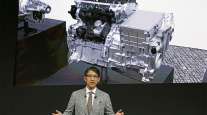Staff Reporter
DOE Eyes Mines as Future Clean Energy Sites

[Stay on top of transportation news: Get TTNews in your inbox.]
Current or abandoned mines are being considered by the U.S. Department of Energy for experimental clean energy sites below the earth’s surface in a new $500 million grant program.
There are 17,750 mine land sites on 1.5 million acres throughout the United States, according to the Environmental Protection Agency.
The federal government estimates that up to 89 gigawatts of clean electricity could be generated if all the U.S. mine land were redeveloped with clean energy projects.
The grants are being handled by DOE’s Office of Clean Energy Demonstrations (OCED) in collaboration with the National Energy Technology Laboratory plus three other DOE offices: Fossil Energy and Carbon Management, Nuclear Energy, and Energy Efficiency and Renewable Energy.
INPUT WANTED: What do YOU think about turning mine lands into clean energy projects? Tell us your thoughts about a new $500M program under @POTUS' Infrastructure Law that will help:
Create jobs
Boost communities' economies
Expand clean energy https://t.co/s5vFfZiL7z — U.S. Department of Energy (@ENERGY) June 29, 2022
Created last year through President Joe Biden’s bipartisan infrastructure law, OCED is appropriated with $500 million for this fiscal year through 2026 to demonstrate the technical and economic viability of two to five clean-energy projects on mine lands in geographically diverse areas.
Projects to be considered for government grants must demonstrate at least one of these technologies: geothermal, energy storage (pumped hydropower and compressed air), direct air capture, advanced nuclear use, microgrids, or fossil-fueled electricity generation with carbon capture, utilization and sequestration. At least two projects must involve solar energy.
In awarding grants, projects will be selected that can be done in the shortest amount of time from permitting to completion, will create the most jobs and are located in economically distressed areas (especially in former coal mining areas). Consideration will also be given to projects with the greatest potential for technological innovation, commercial deployment and the lowest level costs for generated or stored energy.

3PL problem-solvers discuss the supply chain and how they use technology to improve their customer competitiveness. Tune in above or by going to RoadSigns.TTNews.com.
“The selected projects will chart a course to navigate federal, state and local rules and regulations for siting and grid interconnection, mine remediation, post-mining land use, environmental safety and other important processes to successfully develop and operate clean-energy projects on current or former mine land,” according to DOE.
DOE is specifically interested in learning from public input how demonstration programs can be implemented to stimulate private sector follow-on investments and create high-quality jobs, promote local and regional economic development and lower greenhouse gas emissions.
Expected to seek project proposals in 2023, OCED issued a request for information June 29 to seek input from the clean energy industry and its investors, the mining industry and landowners, federal and state regulatory agencies, state and local governments, labor unions, environmental justice organizations, Tribal officials, disadvantaged communities, community-based groups, economic development organizations, conservation and environmental groups, and academic and other research institutions interested in demonstrating clean energy projects on mine lands.
Comments are being sought on mine land development, operations and program implementation, job creation and technology concerns. Also factored in will be federal priorities for equity and environmental and energy justice. Only electronic responses to the mine project information request will be considered and should be sent via email to mineland@hq.doe.gov by Aug. 15.
Further details are available at oced-exchange.energy.gov.
The mine project is to support the Biden Administration’s goal of having a carbon-free electric grid by 2035 and a net zero-emission economy by 2050.
“Developing clean energy on mine lands is an opportunity for fossil fuel communities, which have powered our nation for a generation, to receive an economic boost and play a leadership role in our clean energy transition,” Energy Secretary Jennifer Granholm said when announcing the information request.
In June, Granholm announced an experiment to store hydrogen underground in salt caverns in Utah would receive a $504.4 million loan guarantee after qualifying as a new clean energy technology project. Federal funds will help pay to build the world’s largest clean hydrogen storage able to provide long-term, low-cost, seasonal energy storage for the electrical grid.

A view of the project site. (Advanced Clean Energy Storage Project via U.S. Department of Energy)
The plan is to combine 220 megawatts of alkaline electrolysis with two massive 4.5 million barrel salt caverns to store clean hydrogen and deploy it as fuel for the Intermountain Power Agency power plant that aims to incrementally be fueled 100% by clean hydrogen by 2045.
Earlier this year, ground was broken on the project, called the Advanced Clean Energy Storage Project. It is a joint venture between Mitsubishi Power Americas Inc., Magnum Development and Haddington Ventures.
Want more news? Listen to today's daily briefing below or go here for more info:


